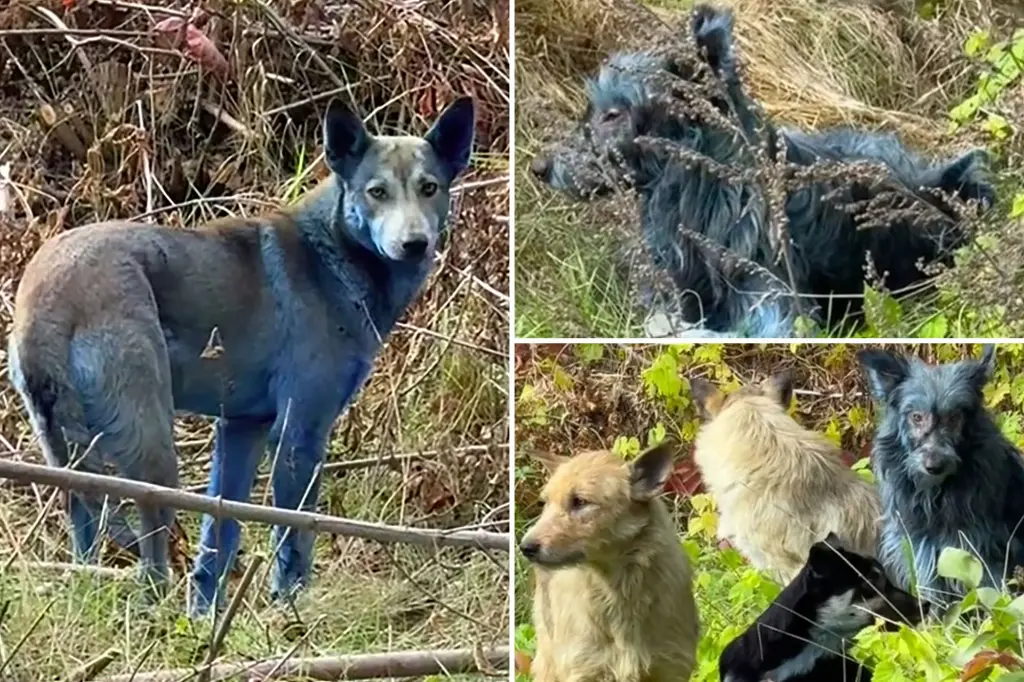Copyright breezyscroll

Shocking new footage from Ukraine’s Chernobyl Exclusion Zone shows several stray dogs with bright blue fur, baffling scientists and animal welfare workers. The unusual sight, captured by the organization Dogs of Chernobyl, has reignited global concern about the long-term environmental impact of the 1986 nuclear disaster. Despite their surreal appearance, the organization says the blue-colored dogs appeared “very active and healthy.” What are the “Dogs of Chernobyl”? The Dogs of Chernobyl are descendants of pets abandoned when over 100,000 people were forced to evacuate following the catastrophic nuclear meltdown at the Chernobyl power plant in April 1986. Over the decades, these dogs have formed packs across the 18-square-mile exclusion zone, living in radioactive ruins and adapting to harsh, isolated conditions. Today, an animal welfare group, also named Dogs of Chernobyl, cares for roughly 700 strays, providing food, medical treatment, and sterilization services to help control the population. These animals have become unlikely symbols of resilience in one of the world’s most toxic environments, where wildlife continues to thrive despite lingering radiation. What caused the dogs’ blue fur? During a recent routine sterilization and medical check, volunteers noticed three dogs with vibrant blue coats. Locals reported that the animals looked completely normal just a week earlier. The sudden transformation stunned caretakers, who initially feared a radiation-related mutation. However, experts now suspect a more immediate environmental cause. Possible explanations include: Contact with industrial chemicals — likely from abandoned factories or waste dumps scattered across the exclusion zone. Exposure to heavy metals such as copper sulfate or cobalt compounds, both known to stain fur and skin in bright blue hues. Chemical runoff from nearby structures, which may have accumulated in soil or water sources where the dogs drink or roll around. Researchers are currently collecting fur, skin, and blood samples for laboratory analysis to determine the exact source. “We do not know the reason and are attempting to catch them so we can find out what is happening,” the organization said. “Most likely they’re getting into some sort of chemical. They seem very active, and at this point, we have not been able to catch them.” Are the blue dogs radioactive? Initial observations suggest the blue color is not directly linked to radiation exposure. Scientists emphasize that radioactive contamination would not typically alter fur pigmentation in such a way. In past cases, animals near industrial sites have developed unusual fur or skin coloration after coming into contact with toxic dyes or metallic residues. Similar incidents have been recorded in Russia and India, where stray dogs turned blue due to pollution from chemical plants. However, researchers are not ruling out radiation as a compounding factor—especially given that the Chernobyl zone’s soil and debris still contain cesium and strontium isotopes that could interact with other chemicals. Why this matters: Chernobyl’s forgotten environmental risks While the story of blue dogs might seem surreal, it underscores a serious reality: the Chernobyl Exclusion Zone remains environmentally unstable nearly four decades later. Wildlife has returned in astonishing numbers, wolves, deer, and even horses roam freely, but scientists warn that exposure to heavy metals, decaying infrastructure, and lingering contamination could have unpredictable biological effects. Experts say this discovery should prompt renewed environmental monitoring in the region, which has been sporadic due to geopolitical tensions and limited access since the Russian invasion of Ukraine. What’s next for the blue dogs? Rescue teams are continuing efforts to safely capture the blue-coated dogs for examination. Once caught, they’ll undergo veterinary testing to confirm whether the coloration poses health risks. Until then, caretakers are warning visitors and workers in the exclusion zone to avoid approaching or touching the animals. The Dogs of Chernobyl organization continues to care for the rest of the canine population, emphasizing that most appear healthy and well-adapted despite the area’s contamination. “They are survivors,” one caretaker said. “Even in this environment, they’ve learned how to live, and they still trust people.” Discovery: Three stray dogs near Chernobyl were found with bright blue fur during a routine health check. Cause: Experts suspect chemical contamination, not radiation. Status: Dogs appear healthy but remain uncaptured for testing. Significance: Highlights ongoing environmental hazards in the Chernobyl Exclusion Zone.



